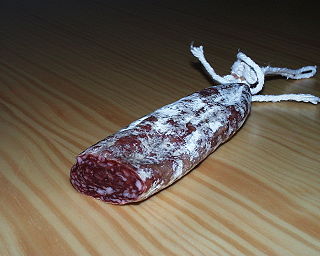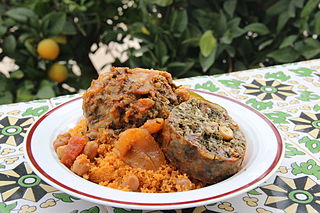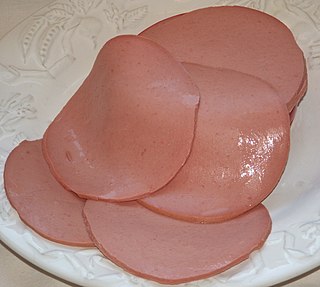Related Research Articles

Cajun cuisine is a style of cooking developed by the Cajun–Acadians who were deported from Acadia to Louisiana during the 18th century and who incorporated West African, French and Spanish cooking techniques into their original cuisine.

Haggis is a savoury pudding containing sheep's pluck, minced with onion, oatmeal, suet, spices, and salt, mixed with stock, and cooked while traditionally encased in the animal's stomach though now an artificial casing is often used instead. According to the 2001 English edition of the Larousse Gastronomique: "Although its description is not immediately appealing, haggis has an excellent nutty texture and delicious savoury flavour".

A sausage is a type of meat product usually made from ground meat—often pork, beef, or poultry—along with salt, spices and other flavourings. Other ingredients, such as grains or breadcrumbs may be included as fillers or extenders.

Salami is a cured sausage consisting of fermented and air-dried meat, typically pork. Historically, salami was popular among Southern, Eastern, and Central European peasants because it can be stored at room temperature for up to 45 days once cut, supplementing a potentially meager or inconsistent supply of fresh meat. Countries and regions across Europe make their own traditional varieties of salami.

A blood sausage is a sausage filled with blood that is cooked or dried and mixed with a filler until it is thick enough to solidify when cooled. Most commonly, the blood of pigs, sheep, lamb, cow, chicken, or goose is used.

Chorizo is a type of pork sausage originating from the Iberian Peninsula. It is made in many national and regional varieties in several countries on different continents. Some of these varieties are quite different from each other, occasionally leading to confusion or disagreements over the names and identities of the products in question.

Boerewors, is a type of sausage which originated in South Africa. It is an important part of South African, Zimbabwean, Zambian, Botswana and Namibian cuisine and is popular across Southern Africa. The name is derived from the Afrikaans words boer and wors ("sausage"). According to South African government regulation, boerewors must contain at least 90 percent meat or fat from beef, pork, lamb or goat. The other 10% is made up of spices and other ingredients. Not more than 30% of the meat content may be fat. Boerewors may not contain offal or any "mechanically recovered" meat pulp.

The Lorne sausage, also known as square sausage or slice, is a traditional Scottish food item made from minced meat, rusk and spices. Although termed a sausage, no casing is used to hold the meat in shape, hence it is usually served as square slices from a formed block. It is a common component of the traditional Scottish breakfast.

Vienna sausage is a thin parboiled sausage traditionally made of pork and beef in a casing of sheep's intestine, then given a low-temperature smoking. The word Wiener is German for 'Viennese'. In Austria, the term "Wiener" is uncommon for this food item, which instead is usually called Frankfurter Würstl.

Thuringian sausage, or Thüringer Bratwurst in German is a unique sausage from the German state of Thuringia which has protected geographical indication status under European Union law.

The origins of meat preservation are lost to the ages but probably began when humans began to realize the preservative value of salt. Sausage making originally developed as a means to preserve and transport meat. Primitive societies learned that dried berries and spices could be added to dried meat. The procedure of stuffing meat into casings remains basically the same today, but sausage recipes have been greatly refined and sausage making has become a highly respected culinary art.

Gelbwurst, meaning “yellow sausage”, is a traditional sausage and deli meat from Bavaria, Germany.

Different areas of the world have local variations on the hot dog, in the type of meat used, the condiments added, and its means of preparation.

Longaniza is a Spanish sausage (embutido) similar to a chorizo and also closely associated with the Portuguese linguiça. Its defining characteristics are interpreted differently from region to region. It is popular in the cuisines of several regions of Spain, Argentina, Uruguay, Puerto Rico, Dominican Republic, El Salvador, Guatemala, Mexico and Chile. In the Philippines, it is called longganisa and has hundreds of variants with different vernacular tastes and forms due to the 144 ethno-linguistic groups of the archipelago.

Usban is a traditional kind of sausage in some North African countries Algeria, Tunisia and Libya, stuffed with a mixture of rice, herbs, lamb, chopped liver and heart. This dish is usually served alongside the main meal of rice or couscous, often on special occasions.

Bologna sausage, informally baloney, is a sausage derived from the Italian mortadella, a similar-looking, finely ground pork sausage, named after the city of Bologna. Typical seasonings for bologna include black pepper, nutmeg, allspice, celery seed and coriander, and, like mortadella, myrtle berries give it its distinctive flavor.
Timoleague Brown Pudding is a variety of brown pudding which was granted Protected Geographical Indication status under European Union law in 1999. In 2012 the sole producer of the pudding Staunton Foods decided to stop using the PGI designation because they felt it wasn't of huge benefit to their business.

Black pudding is a distinct regional type of blood sausage originating in the United Kingdom and Ireland. It is made from pork or occasionally beef blood, with pork fat or beef suet, and a cereal, usually oatmeal, oat groats, or barley groats. The high proportion of cereal, along with the use of certain herbs such as pennyroyal, serves to distinguish black pudding from blood sausages eaten in other parts of the world.

Mombar. is a kind of Arab sausage dish especially popular in Egypt. Syria, Algeria, Tunisia, and Libya. It is made from sheep casing stuffed with a rice and meat mixture and deep fried.
References
- ↑ Gomes, Michael. "An Iftar that reminds one of 'home flavours". Khaleej Times. Retrieved 2020-04-10.
- ↑ "Makanek | Traditional Sausage From Lebanon | TasteAtlas". www.tasteatlas.com. Retrieved 2020-04-10.
- ↑ Holmes, Mona (2019-12-19). "Mona's Kitchen in Tarzana Is 'Worth a Jaunt for Lovers of Lebanese Cuisine'". Eater LA. Retrieved 2020-04-10.